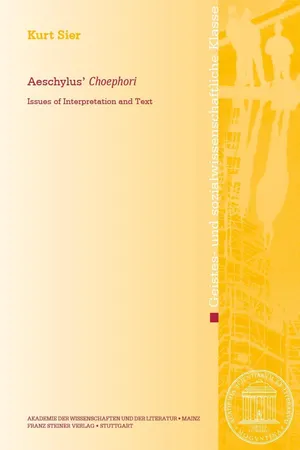
- 76 pages
- English
- PDF
- Available on iOS & Android
About this book
Choephori (or Libation Bearers) is the second play of Aeschylus' Oresteia. It was the main reference point for the Electras of Sophocles and Euripides and may be called the archetype of all later dramatizations of Orestes' matricide. But while Choephori can be considered the most influential part of the tragic trilogy in terms of theater history, it is also, paradoxically, the worst preserved of the three plays, its text resting upon a single medieval manuscript and being corrupt in many places. This is one of the reasons why the drama continues to be controversial to an extent that even by ,Aeschylean' standards seems exceptional. Although there is a vast amount of literature devoted to the Oresteia and there are excellent contributions dealing with its middle play, very many of the problems occurring in Choephori are still unsettled. The present study does not focus on general themes (e.g. justice, gender, intertextuality), albeit such topics will necessarily arise in the course of the argument, nor does it claim to give a new overall interpretation. Rather, it intends to discuss questions concerning structure and performance and to address a number of issues that seem important for understanding the play.
Frequently asked questions
- Essential is ideal for learners and professionals who enjoy exploring a wide range of subjects. Access the Essential Library with 800,000+ trusted titles and best-sellers across business, personal growth, and the humanities. Includes unlimited reading time and Standard Read Aloud voice.
- Complete: Perfect for advanced learners and researchers needing full, unrestricted access. Unlock 1.4M+ books across hundreds of subjects, including academic and specialized titles. The Complete Plan also includes advanced features like Premium Read Aloud and Research Assistant.
Please note we cannot support devices running on iOS 13 and Android 7 or earlier. Learn more about using the app.
Information
Table of contents
- I
- II
- III
- Appendix
- Bibliography